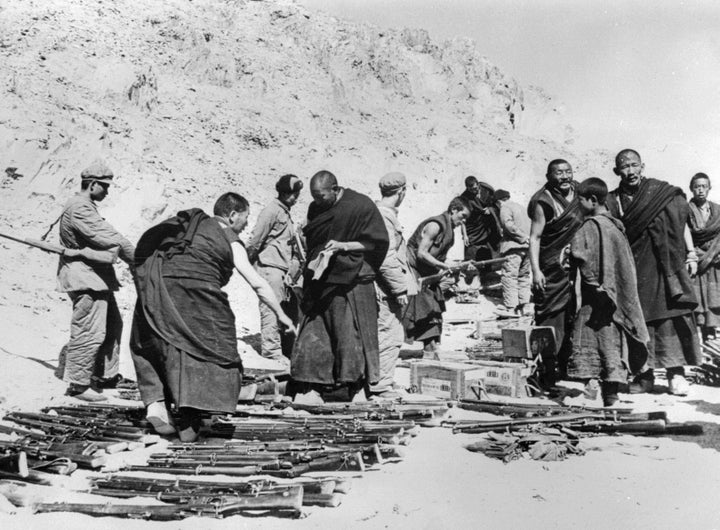
Tibet is, in the West, a story of a small, occupied country. It's a story we understand perfectly -- a weak nation taken over and occupied by a more powerful one. This is, in a way, the American theme, the theme of 1776, when we threw off our own band of occupiers. The narrative has been repeated so many times in so many guises -- from our own misguided take-overs of places like Cuba, to our fight to free France and Poland in World War II -- that any American can understand Tibet in a phrase.
When I went to Lhasa in 2009 to research my book on the Dalai Lama's escape to freedom, I expected to be meet patriots almost exclusively. But I was wrong. The story of modern Tibet is in many ways the story not of nationalism but of Buddhism.
Tibet was for centuries the spiritual locus of the faith. It was a country with a self-professed sacred mission, to keep the flame of the dharma protected against all threats, foreign and domestic. That mission permeated the countryside and the streets of the capitol, Lhasa. It animated Tibetans' lives in a way that is almost incomprehensible to us today.
Then in 1950, Mao invaded across the Ghost River. The Chinese had a long and special relationship with Tibet going back centuries, and they saw Tibet as a breakaway province that had been cut off from the motherland by foreign intriguers. The Tibetans, of course, saw things differently.
At first Mao's occupation was mostly peaceful. The Chinese even did some good, dismantling the more abusive features of a semi-feudal system that kept some poor Tibetans in a condition close to bondage. They also spent money like mad -- the symbol of the early years of the Chinese presence was not the hammer and sickle, not Communism, but the silver coin. The combination worked for a few years.
Crucially, the nominal leader of Tibet, the naive and isolated Dalai Lama, then only 15, believed Mao's promises that he would keep the native features of Tibetan culture while grafting them onto an enlightened socialism. But soon Mao began to show his true hand. Public humiliations began, followed by land seizures and horrible atrocities -- a wave of terror spread over Tibet from the east.
In Tibet this campaign had a special feature. It wasn't only the rich landowners who were targeted viciously, it was the monks and the abbots of the great Tibetan monasteries.
In the March of 1959 -- in spring, the season that has brought so many revolutions -- the Tibetans rose up, believing the Chinese were about to kidnap or kill the Dalai Lama. The Dalai Lama fled on foot and on horseback across the Himalayas towards India and freedom, in a 17-day-escape that made headlines everywhere and turned him into a global personality. Behind him, his people died by the thousands in a bloody, lopsided battle.
What struck me in interviewing survivors of the uprising was its religious undercurrent: If His Holiness had been a secular leader only, most likely Tibetans wouldn't have raised a finger to protect him. Many of them distrusted the aristocrats and bureaucrats who ran the government -- they were seen (correctly) as corrupt allies of the Chinese. It was what the Dalai Lama meant to them as people of faith that caused ordinary Tibetans to risk their lives.
Teenagers who had never been particularly patriotic ran to the Norbulingka, His Holiness's summer palace, to act as human barriers. Older men opened their shirts as they stood in front of the palace gates, daring the Chinese soldiers to gun them down. Monks in the colleges grabbed rifles, dooming themselves to a reincarnation as a lesser being for violating the Buddhist maxim against violence.
None of these people had taken up arms in 1950 when the Chinese invaded their borders. Nationalism didn't rouse a majority of them to fight. The notion of Tibet was too diffuse. Many Tibetans in 1950 didn't even speak the same language; each region had its own dialect that made it impossible to communicate with someone from another province. The only thing that united the far-flung populations was their love of tsampa, the roasted barley that is a staple across the country. And the figure of the Dalai Lama.
I spoke to monks who now live in tiny rooms in the hills of Dharamsala, India, and many told me the same thing: In fighting the Chinese in Lhasa, they believed they were protecting His Holiness as he fled toward freedom. They believed if he was captured, the dharma would be irreparably harmed. Death was a small price to pay if they stop that from happening.
And in talking about the fighting and the horrors they'd seen in the uprising and the often lethal trail to India (80,000 Tibetans escaped in the days and weeks after the rebellion), these men and women rarely mentioned themselves. They didn't dwell on what 1959 had cost them personally. Some seemed puzzled when I asked that typical American question: When you saw an abbott shot down, or your sister killed, what were you feeling? They were confused, and asked me to repeat myself.
These Tibetans had so given themselves over to their beliefs that they quite literally couldn't comprehend what I was saying. I found that quite moving. How many of us could contemplate disaster with such selflessness?
Tibet is a small nation that was occupied by a rising power. Historically, that's a common tragedy. But the Tibetans' grace in enduring it is peculiar to themselves.